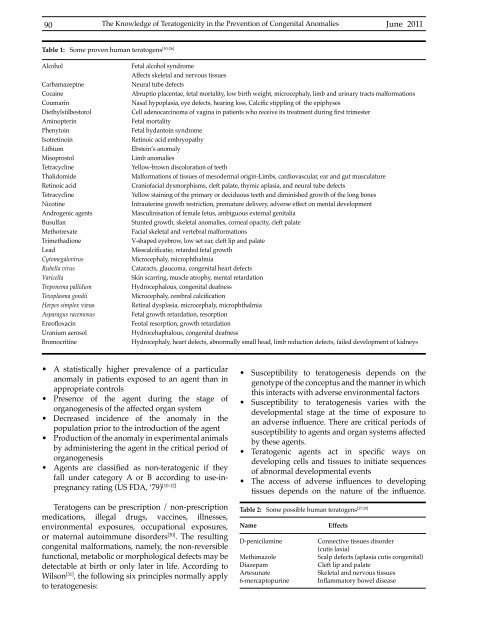Vol 43 # 2 June 2011 - Kma.org.kw
Vol 43 # 2 June 2011 - Kma.org.kw
Vol 43 # 2 June 2011 - Kma.org.kw
You also want an ePaper? Increase the reach of your titles
YUMPU automatically turns print PDFs into web optimized ePapers that Google loves.
90<br />
The Knowledge of Teratogenicity in the Prevention of Congenital Anomalies<br />
<strong>June</strong> <strong>2011</strong><br />
Table 1: Some proven human teratogens [10-26]<br />
Alcohol<br />
Carbamazepine<br />
Cocaine<br />
Coumarin<br />
Diethylstilbestorol<br />
Aminopterin<br />
Phenytoin<br />
Isotretinoin<br />
Lithium<br />
Misoprostol<br />
Tetracycline<br />
Thalidomide<br />
Retinoic acid<br />
Tetracycline<br />
Nicotine<br />
Androgenic agents<br />
Busulfan<br />
Methotrexate<br />
Trimethadione<br />
Lead<br />
Cytomegalovirus<br />
Rubella virus<br />
Varicella<br />
Treponema pallidum<br />
Toxoplasma gondii<br />
Herpes simplex virus<br />
Asparagus racemosus<br />
Enrofloxacin<br />
Uranium aerosol<br />
Bromocritine<br />
Fetal alcohol syndrome<br />
Affects skeletal and nervous tissues<br />
Neural tube defects<br />
Abruptio placentae, fetal mortality, low birth weight, microcephaly, limb and urinary tracts malformations<br />
Nasal hypoplasia, eye defects, hearing loss, Calcific stippling of the epiphyses<br />
Cell adenocarcinoma of vagina in patients who receive its treatment during first trimester<br />
Fetal mortality<br />
Fetal hydantoin syndrome<br />
Retinoic acid embryopathy<br />
Ebstein’s anomaly<br />
Limb anomalies<br />
Yellow-brown discoloration of teeth<br />
Malformations of tissues of mesodermal origin-Limbs, cardiovascular, ear and gut musculature<br />
Craniofacial dysmorphisms, cleft palate, thymic aplasia, and neural tube defects<br />
Yellow staining of the primary or deciduous teeth and diminished growth of the long bones<br />
Intrauterine growth restriction, premature delivery, adverse effect on mental development<br />
Masculinisation of female fetus, ambiguous external genitalia<br />
Stunted growth, skeletal anomalies, corneal opacity, cleft palate<br />
Facial skeletal and vertebral malformations<br />
V-shaped eyebrow, low set ear, cleft lip and palate<br />
Misscalcificatio, retarded fetal growth<br />
Microcephaly, microphthalmia<br />
Cataracts, glaucoma, congenital heart defects<br />
Skin scarring, muscle atrophy, mental retardation<br />
Hydrocephalous, congenital deafness<br />
Microcephaly, cerebral calcification<br />
Retinal dysplasia, microcephaly, microphthalmia<br />
Fetal growth retardation, resorption<br />
Feotal resorption, growth retardation<br />
Hydrocehaphalous, congenital deafness<br />
Hydrocephaly, heart defects, abnormally small head, limb reduction defects, failed development of kidneys<br />
• A statistically higher prevalence of a particular<br />
anomaly in patients exposed to an agent than in<br />
appropriate controls<br />
• Presence of the agent during the stage of<br />
<strong>org</strong>anogenesis of the affected <strong>org</strong>an system<br />
• Decreased incidence of the anomaly in the<br />
population prior to the introduction of the agent<br />
• Production of the anomaly in experimental animals<br />
by administering the agent in the critical period of<br />
<strong>org</strong>anogenesis<br />
• Agents are classified as non-teratogenic if they<br />
fall under category A or B according to use-inpregnancy<br />
rating (US FDA, ‘79) [10-12]<br />
Teratogens can be prescription / non-prescription<br />
medications, illegal drugs, vaccines, illnesses,<br />
environmental exposures, occupational exposures,<br />
or maternal autoimmune disorders [30] . The resulting<br />
congenital malformations, namely, the non-reversible<br />
functional, metabolic or morphological defects may be<br />
detectable at birth or only later in life. According to<br />
Wilson [31] , the following six principles normally apply<br />
to teratogenesis:<br />
• Susceptibility to teratogenesis depends on the<br />
genotype of the conceptus and the manner in which<br />
this interacts with adverse environmental factors<br />
• Susceptibility to teratogenesis varies with the<br />
developmental stage at the time of exposure to<br />
an adverse influence. There are critical periods of<br />
susceptibility to agents and <strong>org</strong>an systems affected<br />
by these agents.<br />
• Teratogenic agents act in specific ways on<br />
developing cells and tissues to initiate sequences<br />
of abnormal developmental events<br />
• The access of adverse influences to developing<br />
tissues depends on the nature of the influence.<br />
Table 2: Some possible human teratogens [27-29]<br />
Name<br />
D-penicilamine<br />
Methimazole<br />
Diazepam<br />
Artesunate<br />
6-mercaptopurine<br />
Effects<br />
Connective tissues disorder<br />
(cutis laxia)<br />
Scalp defects (aplasia cutis congenital)<br />
Cleft lip and palate<br />
Skeletal and nervous tissues<br />
Inflammatory bowel disease
















